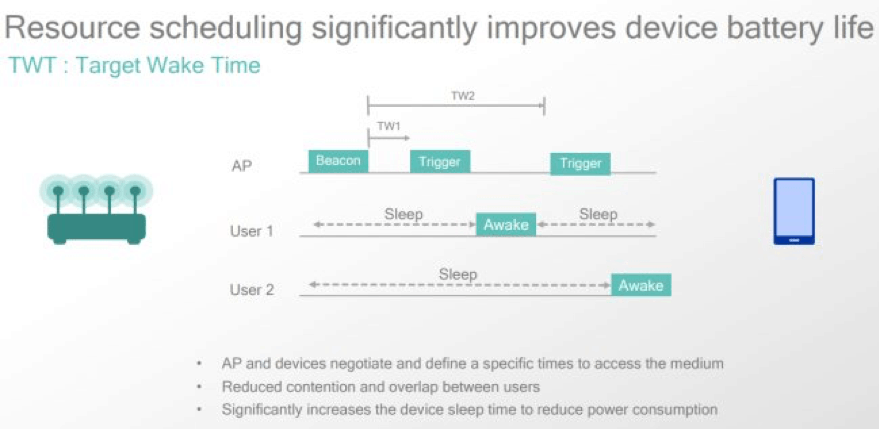
The new standard for wireless LANs has been named by the IEE as 802.11ax or WiFi 6 as it is more commonly known. As a standard, it’s going to be ratified some time towards the late end of 2019 or early 2020. WiFi 6 has been designed in order to address a number of limitations of current WiFi systems:
- Increase data transfer speeds
- Optimise the allocation of bandwidth amongst several devices concurrently connected
- Reliably deliver resource for high bandwidth applications compared to WiFi 5
The new naming standard
The 802.11ax standard is also known as ‘High-Efficiency Wireless’ but will be marketed as and more commonly referred to as WiFi 6. Essentially this is a new naming standard that has been set by the Wi-Fi Alliance®. Previous versions of the standard are now being labelled as Wifi 5 (802.11ac) and WiFi 4 (802.11n) retrospectively. This is a new naming standard set by the Wi-Fi Alliance®, with previous generations now being retroactively labelled as WiFi 5 (802.11ac) and WiFi 4 (802.11n). This new naming convention will be displayed on devices using the icons below:
![]()
Although the IEEE 802.xx naming convention has been relatively easy to understand for technical personnel, this hasn’t always been the case for end-users. Thus in order to make it easier for end-users to understand which of the standards are supported by each WiFi device new, simpler names and icons have been developed.
Faster data transfer speeds
WiFi 6 promises data rates for single users which are approximately 40% faster than 802.11ac (WiFi 5). This is made possible by more efficient data encoding which results in higher data throughput. Essentially, more data is packed into the same radio wave. The new WiFi 6 standard also improves the performance on 2.4GHz networks. Despite the large investments of the industry on the 5GHz band in order to reduce interferences, WiFi 6 will be even better at penetrating physical obstacles.WiFi 6’s predecessor, 802.11ac, only uses bands in the 5GHz spectrum. The new standard operates across the 2.4GHz and 6GHz frequencies. Eventually, expansion of the spectrum will include bands in 1GHz and 6GHz range as they become available.
Better performance in dense environments
It is generally the case that WiFi performance tends to get worse the more crowded a location becomes. This is generally this is the case in areas such as stadiums, airports, malls and offices where many WiFi-enabled devices are connected to the network concurrently. The great news is that the WiFi 6 standard incorporates a number of new technologies designed to overcome this issue. Accordingly, to Intel, the new technology will improve the average speed for each user by at least four times in congested areas.
Extended battery life for client devices
One of the most significant advances for WiFi 6 is the introduction of the new ‘Target Wake Time’ feature. TWT enables access points to instruct connected devices exactly when and how frequently they are required to ‘wake up’ in order to send or receive data. The implementation of this strategy will reduce power consumption and improve spectral efficiency. This technology will be very useful for both mobile and IoT devices. These devices will effectively be able to increase their sleep time and consequently extend battery life. Target Wake Time, in addition to saving power on the client device side, also enables wireless access points and devices to define and negotiate specific times to access the medium, reducing contention and overlap between users.

Image source: Qualcomm
When will we expect WiFi 6 to arrive?
Some manufacturers already have products available which support the new standard. Many products were also presented during the CES2019 event. However, 802.11ax WiFi won’t be ratified until somewhere around the end of 2019.
The important thing to remember is that at the moment there are not many WiFi 6 client devices available. However, you can expect that to change quite quickly over the next few months as many manufacturers will be rolling out new products. Until these products are in consumers’ hands they won’t truly realise the benefits of WiFi 6. However, infrastructure needs to be updated now, in order to prepare for the influx of WiFi 6 compatible devices that consumers will want to make use of.
